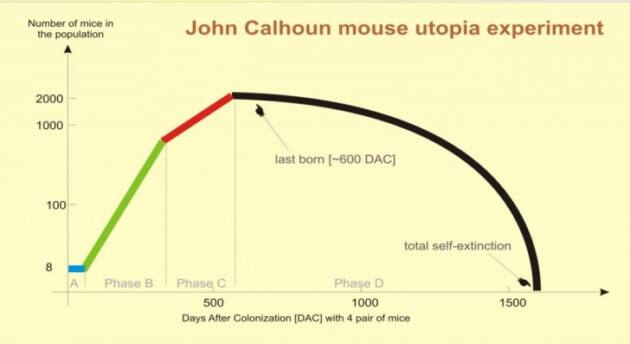

The “common” mice seemed to accept this state of affairs, to the point that when the inevitable violence started eating away the population, the Beautiful Ones were spared from the massacre. Guarded by wildly territorial males that prevented the rest of the population from entering the premises, these largely female populations spent their entire existence grooming themselves, eating, and sleeping. It was because the limited secluded spaces were taken up by “The Beautiful Ones” - an elite class that formed within the mouse society of Universe 25. The reason most of the mice were hunched up in the common spaces was even creepier than their bored apathy. Very few pregnancies were carried to term, and females treated their litters as afterthoughts that were soon forgotten. Apathy and annoyance were the prevailing moods, as the mice hunched in the main squares, waiting to be fed and occasionally attacking each other. Most mice spent every second of their lives surrounded by hundreds of their kin. By Day 560 of the experiment, the population of Universe 25 reached a whopping 2,200 rodents, who proceeded to prove that even for animals, hell is other people. His hunch was correct, as the mice used their paradise to procreate as rapidly as they could.

He called his creation “Universe 25,” and because it was indeed the 25th environment he had created, he had a pretty good idea that things might not stay heavenly for too long. In 1972, he attempted to create heaven for eight mice … who promptly went and turned it into hell in a self-destructive pattern called “the behavioral sink.”Ĭalhoun designed the structure as an ultimate utopia for a mouse: There were beautiful buildings, communal spaces, ample personal quarters and an unlimited supply of food. The Mouse Utopiaįrom the 1950s to 1970s, animal behavior researcher John Calhoun built artificial environments for rodents to study their behavior. Let’s take a look at some of the most terrifying cases.
#MOUSE UTOPIA EXPERIMENT CRITICISM MOVIE#
However, every once in a while, those tests go so badly wrong that the end result seems more like a horror movie than a well thought-out scientific experiment. They’re just science doing what science does best: To better understand how we behave, researchers sometimes have to conduct a test or two. Behavioral experiments are not evil by default.


 0 kommentar(er)
0 kommentar(er)
